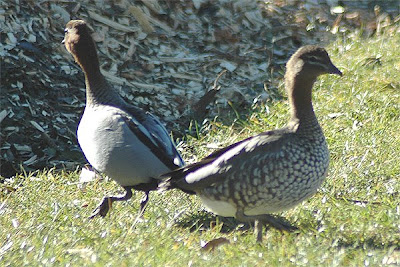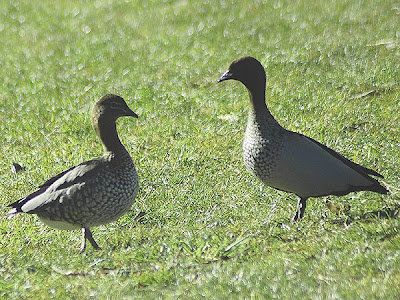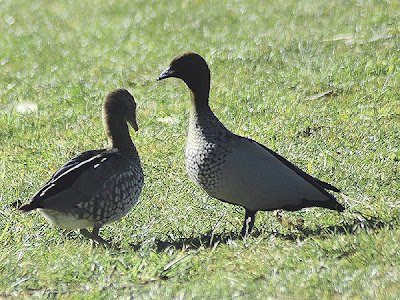In the centre of Robertson there is a park, Hampden Park, which has playing fields, and a creek "Caalang Creek", which runs through it. The combination of fresh green grass, and water is perfect for Australian Wood Ducks (Chenonetta jubata). These birds are dry country grazers, as distinct from "dabbling ducks" which often up-end themselves, when feeding (when swimming), to feed on water weeds. The phrase: "Dry country" is relative. I should say grass eaters. The grass of Robertson is pretty lush and green, as you can tell from the background colours. But they also hang out in mobs around "farm dams" in genuinely dry land areas.
Wood Ducks (or "Maned Geese" as I grew up calling them), are good walkers, even capable of getting up a pretty good pace on land, as opposed to Black Ducks, which are adapted to swimming, and have their legs positioned further down the body. Black Ducks are not good runners on dry land.
The male has a darker head, and very fine markings (which look uniformly grey) on his flanks and lower chest. The female has large spots on her chest, which markings tend to extend down the breast. She has a slight pale ring around her eye. His posture is nearly always more upright than hers, making him look taller, but it is probably his posture, rather than his size.
Although the male (on the left) has turned his head away, you can actually see the shape of the head, and the way the skull of these birds is shaped in such a way as to allow close to 300 degree vision - perfect for birds which are subject to predation, because they spend so much time on the ground. Although his head is facing away, he could still see me taking his photograph.
These photos are displayed in the same sequence as they were taken, to show the body language of these birds.
 The males are always very watchful, especially when they have chicks. But when that happens, it is the females who do the "guarding", and the male does the "watching out". I saw the first "chicks" (ducklings) on 8 September last year - a mere 6 weeks away from this time. So, I would expect this pair to be actively breeding shortly.
The males are always very watchful, especially when they have chicks. But when that happens, it is the females who do the "guarding", and the male does the "watching out". I saw the first "chicks" (ducklings) on 8 September last year - a mere 6 weeks away from this time. So, I would expect this pair to be actively breeding shortly.Here the female walks back to the male, perhaps for protection, or reassurance.
 Seen below is a clear "bonding" posture. She has to be saying something privately to him - whether in words, or gesture. There is a definite communication going on here.
Seen below is a clear "bonding" posture. She has to be saying something privately to him - whether in words, or gesture. There is a definite communication going on here. Now they set off together, walking back towards me, trying to get past my parked car.
Now they set off together, walking back towards me, trying to get past my parked car. The female is making a quick move, now.
The female is making a quick move, now. I expect to see ducklings in 2 months.
I expect to see ducklings in 2 months.

7 comments:
A good sequence of photos! The chicks have really nice markings too. We've had several pairs - and chicks - parading around the vacant blocks close by over the last couple of years.
We have 12 domestic ducks of various breeds. The social interaction is fascinating. The range of vocalisations, head bobbing, aggressive stances etc I reckon a life time wouldn't be enough to figure it all out.
Wood Ducks are not too common around here but a couple of weeks back I seen a flock of 30+. No luck getting a photo.
G'day Denis,
Nice one. I see the 'woodies' on the golf course have been pairing up too.
Regards,
Gouldiae.
hi Denis,
thanks for the reminder that these cute creatures will soon be breeding.
I am fortunate to sometimes have these ducks grazing in the paddock directly behind my yard, and have even had them in my yard.
They are common sights along the road to town (8kms), and one does have to be careful when they are out wandering with love on their minds and not taking heed of the approaching traffic.
Great post.
cheers
Gaye
Hi folks
Thanks for your comments.
Wood Ducks do seem to be sentimental favourites, possibly because they live their lives so publicly, and their ducklings are so cute, when they arrive.
Mick, it was the opportunity to take the sequence which turned a dull photo into story. Thanks for noticing.
Gaye, the real road hazard is when they are walking their babies to the creek or dam. I saw a whole family of chicks, plus Mum, run over on a busy main road in Canberra once. Terrible.
Denis
Very good Denis. The Wood Ducks are in evidence along the Huon River in Southern Tasmania right now. They hang around with the Black Swans. I don't know much about them, but they do seem to be in pairs, as per your sequence.
Hi Mark
From what I hear of the weather in Tassie, they might be keeping eachother warm!
<
Good to hear your report. Very popular birds, because they are not shy, and look cute, and are very good at making friends with people in parks, etc.
<
Denis
Post a Comment